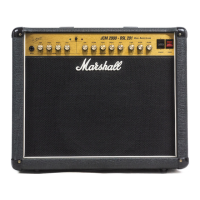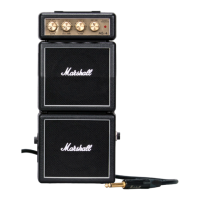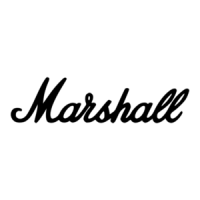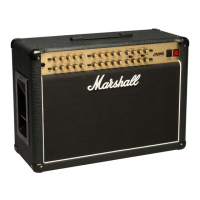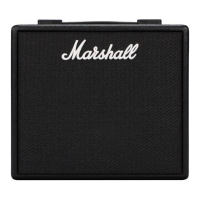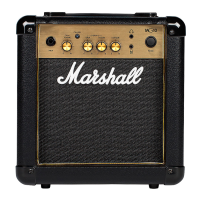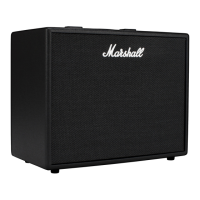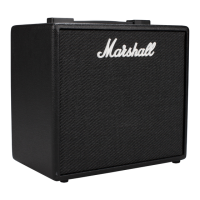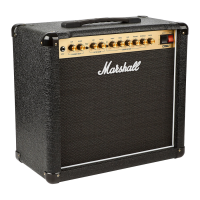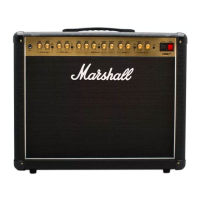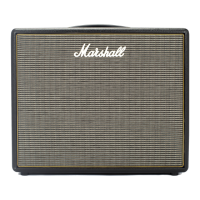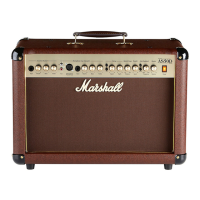Do you have a question about the Marshall Amplification 4001 and is the answer not in the manual?
Controls total mains power to the amplifier.
Controls H.T. supply to amp valves, allowing filaments to remain heated.
Connects instrument; top input is high power, bottom is low power.
High input for high gain, low input for low gain; treble boosted.
Controls the overall output level of channel 2.
Controls the overall output level of channel 1.
Controls the high frequency content of the amplifier.
Controls the middle register of the amplifier.
Controls the low frequency content of the amplifier.
Adds boost to upper frequencies for crispness and liveliness.
Controls total mains power to the amplifier.
Controls H.T. supply to amp valves, allowing filaments to remain heated.
Connects instrument; high input offers more volume than low input.
Controls pre-amp volume for overdrive amount; full setting yields max overdrive.
Controls the overall output level of the amplifier.
Controls the high frequency content of the amplifier.
Controls the middle register; affects treble/bass at high levels.
Controls the low frequencies of the amplifier.
Adds boost to upper frequencies for crispness and liveliness.
Use correct value fuse; note position reversal on certain models.
Use correct value fuse; note position reversal on certain models.
Connects amplifier to power supply; position noted for specific models.
Matches amplifier output transformer to incoming mains voltage.
Matches output transformer impedance to loudspeaker load impedance (4/8/16 ohms).
Parallel jacks for loudspeaker connection; impedance must match selector, not less than 4 ohms.
Low-level output jack for recording, P.A. mixing, or slave systems.
Diagram illustrating how to link two amplifiers for expanded sound capabilities.
Details input signal levels and overload capacity for channels 1 and 2.
Specifies typical power at clipping and 10% distortion for various impedances.
Defines frequency response curves for treble, middle, bass, and presence controls.
Lists mains input voltage, consumption, and fuse ratings.
Details the types and locations of preamp and power output valves.
Details input signal levels and overload capacity for channels 1 and 2.
Specifies typical power at clipping and 10% distortion for various impedances.
Defines frequency response curves for treble, middle, bass, and presence controls.
Lists mains input voltage, consumption, and fuse ratings.
Details the types and locations of preamp and power output valves.
Details low and high sensitivity input levels and overload capacity.
Specifies typical power at clipping and 10% distortion for various impedances.
Defines frequency response for treble, middle, bass, and presence controls.
Lists mains input, consumption, and fuse ratings.
Details preamp and power output valve types.
Details low and high sensitivity input levels and overload capacity.
Specifies typical power at clipping and 10% distortion for various impedances.
Defines frequency response for treble, middle, bass, and presence controls.
Lists mains input, consumption, and fuse ratings.
Details preamp and output valve types.
Connects instrument to amplifier (high powered input).
Connects instrument to amplifier (low powered input).
Controls pre-amplification level for overdrive or cleaner sound.
Controls the overall output level of the amplifier.
Controls the high frequency content of the amplifier.
Controls the middle register of the amplifier.
Controls the low frequencies of the amplifier.
Boosts upper frequencies for crispness and liveliness (not on 5002/5005).
Low-level output for recording, P.A. mixing, or outboard systems.
Output for headphones; mutes internal loudspeaker.
On/off switch for mains power to the amplifier.
Specifies low and high input sensitivity levels.
Defines frequency response for treble, middle, and bass controls.
Details loudspeaker specifications and H.P./Line-out outputs.
Specifies internal power supply settings and fuse.
Specifies fuse values for 120v and 220/240v.
Specifies low and high input sensitivity levels.
Defines frequency response for treble, middle, and bass controls.
Details loudspeaker specifications and H.P./Line-out outputs.
Specifies internal power supply settings and fuse.
Specifies fuse values for 120v and 220/240v.
Details maximum input level and sensitivity.
Defines frequency response for bass, middle, and treble controls.
Specifies RMS power output and construction type.
Details the specially designed 12-inch loudspeaker.
Lists mains input voltage and fuse specifications.
Specifies headphone output power.
Specifies line-out output level.
Connects instrument to amplifier.
Controls pre-amplification level for overdrive or cleaner sound.
Controls the overall output level of the amplifier.
Controls the high frequency content of the amplifier.
Controls the middle register of the amplifier.
Controls the low frequencies of the amplifier.
Controls the depth of the reverb effect.
Provides a low level version of the amplifier output.
Output for headphones; mutes internal loudspeaker. Use stereo headphones.
On/Off for mains power to the amplifier.
Connects instrument to amplifier.
Controls pre-amplification level for overdrive or cleaner sound.
Controls the overall output level of the amplifier.
Controls the high frequency content of the amplifier.
Controls the middle register of the amplifier.
Controls the low frequencies of the amplifier.
Adds boost to upper frequencies for crispness and liveliness.
Controls the depth of the reverb effect.
Output for stereo headphones; mutes internal loudspeaker.
Low-level output for recording, P.A. mixing, or slave systems.
On/Off for mains power to the amplifier.
Connects instrument to amplifier.
Controls input level for overdrive or clean settings.
Controls the high frequency content of the amplifier.
Controls the mid range of the amplifier.
Controls the low frequencies of the amplifier.
Controls the overall volume level of the amplifier.
Controls H.T. supply to amp valves, allowing filaments to remain heated.
Controls total mains power to the amplifier.
Connects the amplifier to mains power supply.
See label on amp back for correct fuse value.
XLR socket for connection to balanced line outboard equipment.
Output for internal or external loudspeaker (8 ohm nominal, 15 watts R.M.S.).
Output for headphones; operative when speaker is disconnected.
Unbalanced line-out for connecting amplifier to unbalanced outboard equipment.
Specifies sensitivity, overload level, and impedance.
Details RMS power output at varying distortion levels.
Specifies headphone output power at clipping.
Specifies line-out level for 600 ohms and 10 kilohms.
Describes XLR output and pin configuration.
Provides signal-to-noise ratio for flat response and maximum sensitivity.
Integral to power amp section, infinitely variable.
Lists preamp and power output valve types.
Specifies internal power settings and quiescent/clipping consumption.
Details the 12-inch Celestion driver specifications.
Connects instrument to amplifier (high powered input).
Connects instrument to amplifier (low powered input).
Controls pre-amplification level for overdrive or cleaner sound.
Controls the overall output level of the amplifier.
Controls the high frequency content of the amplifier.
Controls the middle register of the amplifier.
Controls the low frequency content of the amplifier.
Low-level output for recording, P.A. mixing, or other systems.
Jack socket for headphones; mutes loudspeakers.
On/off for mains power to the amplifier.
Connects the amplifier to the mains power supply.
For connection of loudspeakers (not less than 8ohms); supplied speakers are 16ohms.
Lists essential safety practices including plug wiring, earthing, and fuse usage.
Emphasizes never operating without an earth, bypassing fuses, or using in damp conditions.
Advises against user servicing and recommends qualified personnel for repair.
Ensures loudspeaker is connected before switching on and impedance is matched.
Do not obstruct airflow and only use Marshall approved replacement components.
Controls total mains power to the amplifier.
Controls H.T. supply to amp valves, allowing filaments to remain heated.
Connects instrument; top input is high power, bottom is low power.
High input for high gain, low input for low gain; treble boosted.
Controls the overall output level of channel 2.
Controls the overall output level of channel 1.
Controls the high frequency content of the amplifier.
Controls the middle register of the amplifier.
Controls the low frequency content of the amplifier.
Adds boost to upper frequencies for crispness and liveliness.
Controls total mains power to the amplifier.
Controls H.T. supply to amp valves, allowing filaments to remain heated.
Connects instrument; high input offers more volume than low input.
Controls pre-amp volume for overdrive amount; full setting yields max overdrive.
Controls the overall output level of the amplifier.
Controls the high frequency content of the amplifier.
Controls the middle register; affects treble/bass at high levels.
Controls the low frequencies of the amplifier.
Adds boost to upper frequencies for crispness and liveliness.
Use correct value fuse; note position reversal on certain models.
Use correct value fuse; note position reversal on certain models.
Connects amplifier to power supply; position noted for specific models.
Matches amplifier output transformer to incoming mains voltage.
Matches output transformer impedance to loudspeaker load impedance (4/8/16 ohms).
Parallel jacks for loudspeaker connection; impedance must match selector, not less than 4 ohms.
Low-level output jack for recording, P.A. mixing, or slave systems.
Diagram illustrating how to link two amplifiers for expanded sound capabilities.
Details input signal levels and overload capacity for channels 1 and 2.
Specifies typical power at clipping and 10% distortion for various impedances.
Defines frequency response curves for treble, middle, bass, and presence controls.
Lists mains input voltage, consumption, and fuse ratings.
Details the types and locations of preamp and power output valves.
Details input signal levels and overload capacity for channels 1 and 2.
Specifies typical power at clipping and 10% distortion for various impedances.
Defines frequency response curves for treble, middle, bass, and presence controls.
Lists mains input voltage, consumption, and fuse ratings.
Details the types and locations of preamp and power output valves.
Details low and high sensitivity input levels and overload capacity.
Specifies typical power at clipping and 10% distortion for various impedances.
Defines frequency response for treble, middle, bass, and presence controls.
Lists mains input, consumption, and fuse ratings.
Details preamp and power output valve types.
Details low and high sensitivity input levels and overload capacity.
Specifies typical power at clipping and 10% distortion for various impedances.
Defines frequency response for treble, middle, bass, and presence controls.
Lists mains input, consumption, and fuse ratings.
Details preamp and output valve types.
Connects instrument to amplifier (high powered input).
Connects instrument to amplifier (low powered input).
Controls pre-amplification level for overdrive or cleaner sound.
Controls the overall output level of the amplifier.
Controls the high frequency content of the amplifier.
Controls the middle register of the amplifier.
Controls the low frequencies of the amplifier.
Boosts upper frequencies for crispness and liveliness (not on 5002/5005).
Low-level output for recording, P.A. mixing, or outboard systems.
Output for headphones; mutes internal loudspeaker.
On/off switch for mains power to the amplifier.
Specifies low and high input sensitivity levels.
Defines frequency response for treble, middle, and bass controls.
Details loudspeaker specifications and H.P./Line-out outputs.
Specifies internal power supply settings and fuse.
Specifies fuse values for 120v and 220/240v.
Specifies low and high input sensitivity levels.
Defines frequency response for treble, middle, and bass controls.
Details loudspeaker specifications and H.P./Line-out outputs.
Specifies internal power supply settings and fuse.
Specifies fuse values for 120v and 220/240v.
Details maximum input level and sensitivity.
Defines frequency response for bass, middle, and treble controls.
Specifies RMS power output and construction type.
Details the specially designed 12-inch loudspeaker.
Lists mains input voltage and fuse specifications.
Specifies headphone output power.
Specifies line-out output level.
Connects instrument to amplifier.
Controls pre-amplification level for overdrive or cleaner sound.
Controls the overall output level of the amplifier.
Controls the high frequency content of the amplifier.
Controls the middle register of the amplifier.
Controls the low frequencies of the amplifier.
Controls the depth of the reverb effect.
Provides a low level version of the amplifier output.
Output for headphones; mutes internal loudspeaker. Use stereo headphones.
On/Off for mains power to the amplifier.
Connects instrument to amplifier.
Controls pre-amplification level for overdrive or cleaner sound.
Controls the overall output level of the amplifier.
Controls the high frequency content of the amplifier.
Controls the middle register of the amplifier.
Controls the low frequencies of the amplifier.
Adds boost to upper frequencies for crispness and liveliness.
Controls the depth of the reverb effect.
Output for stereo headphones; mutes internal loudspeaker.
Low-level output for recording, P.A. mixing, or slave systems.
On/Off for mains power to the amplifier.
Connects instrument to amplifier.
Controls input level for overdrive or clean settings.
Controls the high frequency content of the amplifier.
Controls the mid range of the amplifier.
Controls the low frequencies of the amplifier.
Controls the overall volume level of the amplifier.
Controls H.T. supply to amp valves, allowing filaments to remain heated.
Controls total mains power to the amplifier.
Connects the amplifier to mains power supply.
See label on amp back for correct fuse value.
XLR socket for connection to balanced line outboard equipment.
Output for internal or external loudspeaker (8 ohm nominal, 15 watts R.M.S.).
Output for headphones; operative when speaker is disconnected.
Unbalanced line-out for connecting amplifier to unbalanced outboard equipment.
Specifies sensitivity, overload level, and impedance.
Details RMS power output at varying distortion levels.
Specifies headphone output power at clipping.
Specifies line-out level for 600 ohms and 10 kilohms.
Describes XLR output and pin configuration.
Provides signal-to-noise ratio for flat response and maximum sensitivity.
Integral to power amp section, infinitely variable.
Lists preamp and power output valve types.
Specifies internal power settings and quiescent/clipping consumption.
Details the 12-inch Celestion driver specifications.
Connects instrument to amplifier (high powered input).
Connects instrument to amplifier (low powered input).
Controls pre-amplification level for overdrive or cleaner sound.
Controls the overall output level of the amplifier.
Controls the high frequency content of the amplifier.
Controls the middle register of the amplifier.
Controls the low frequency content of the amplifier.
Low-level output for recording, P.A. mixing, or other systems.
Jack socket for headphones; mutes loudspeakers.
On/off for mains power to the amplifier.
Connects the amplifier to the mains power supply.
For connection of loudspeakers (not less than 8ohms); supplied speakers are 16ohms.
Lists essential safety practices including plug wiring, earthing, and fuse usage.
Emphasizes never operating without an earth, bypassing fuses, or using in damp conditions.
Advises against user servicing and recommends qualified personnel for repair.
Ensures loudspeaker is connected before switching on and impedance is matched.
Do not obstruct airflow and only use Marshall approved replacement components.
| Model | 4001 |
|---|---|
| Channels | 1 |
| Controls | Volume |
| Outputs | 1 x 1/4" Jack |
| EQ | 3-Band |
| Type | Bass Amplifier |
| Output | 100 Watts RMS |
